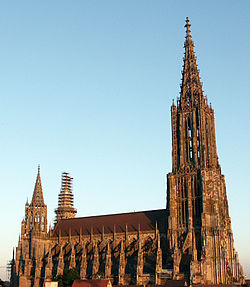
Back Ulm Minster Afrikaans Ulmer Münster ALS أولم مينستر Arabic كنيسه اولم مينستر ARZ Ilesia mayor d'Ulm AST Ulm Kafedralı Azerbaijani Ульмскі сабор Byelorussian Ульмскі сабор BE-X-OLD Улмска катедрала Bulgarian উল্ম গির্জা Bengali/Bangla
| Ulm Minster | |
|---|---|
Ulmer Münster (German) | |
 Ulm Minster, aerial view (2014) | |
| 48°23′55″N 9°59′33″E / 48.39861°N 9.99250°E | |
| Location | Ulm |
| Country | Germany |
| Denomination | Lutheran |
| Previous denomination | Catholic |
| Website | www |
| History | |
| Status | Minster Parish church |
| Architecture | |
| Functional status | Active |
| Architect(s) | Heinrich Parler |
| Architectural type | Minster |
| Style | Gothic |
| Groundbreaking | 1377 |
| Specifications | |
| Capacity | 2,000 |
| Number of spires | 3 |
| Bells | 13 |
| Administration | |
| Division | Evangelical-Lutheran Church in Württemberg[1] |
Building details | |
 | |
| Record height | |
| Tallest in the world from 1890 to 1894[I] | |
| Preceded by | Cologne Cathedral |
| Surpassed by | Philadelphia City Hall |
| General information | |
| Construction started | 1377 |
| Completed | 31 May 1890 |
| Height | 161.5 m (530 ft) |
| References | |
| [2] | |


Ulm Minster (German: Ulmer Münster) is a Lutheran church located in Ulm, State of Baden-Württemberg (Germany). It is the tallest church in the world.[3] The church is the fifth-tallest structure built before the 20th century, with a steeple measuring 161.53 metres.[3]
Though it is sometimes referred to as Ulm Cathedral because of its great size, the church is not a cathedral as it has never been the episcopal see of a bishop. Though the towers and all decorative elements are of stone masonry, attracting the attention of visitors, most of the walls, including the façades of the nave and choir, actually consist of visible brick. Therefore, the building is sometimes referred to as a brick church. As such, it lays claim to the rank of second- to fourth-largest, after San Petronio Basilica in Bologna and together with Frauenkirche in Munich and St. Mary's Church in Gdańsk. The tower however was mainly built from sandstone.[4]
Ulm Minster was begun in the Gothic architecture of the Late Middle Ages but the building was not completed until the late 19th century after a hiatus of centuries. When work ceased in the 16th century all of the church except the towers and some outer decorations were complete, unlike at Cologne Cathedral, where less than half of the work had been done before construction halted in the 15th century.
Visitors can climb the 768 steps that lead to the top of the minster's spire. At 143 m (469 ft) it gives a panoramic view of Ulm in Baden-Württemberg and Neu-Ulm in Bavaria and, in clear weather, a vista of the Alps from Säntis to the Zugspitze. The final stairwell to the top (known as the third Gallery) is a tall, spiralling staircase that has barely enough room for one person.
- ^ "Herzlich Willkommen in der Münstergemeinde Ulm" [Welcome to the Münster community of Ulm] (in German). Retrieved 27 September 2018.
- ^ "Emporis building ID 127335". Emporis. Archived from the original on 17 April 2019.
{{cite web}}: CS1 maint: unfit URL (link) - ^ a b Oggins, Robin O. (2000). Cathedrals. Sterling Publishing Company, Inc. p. 82. ISBN 978-1567993462.
- ^ "Forscherin findet heraus, woher Baumaterial fürs Münster kam | Südwest Presse Online". www.swp.de. Archived from the original on 3 June 2020.
